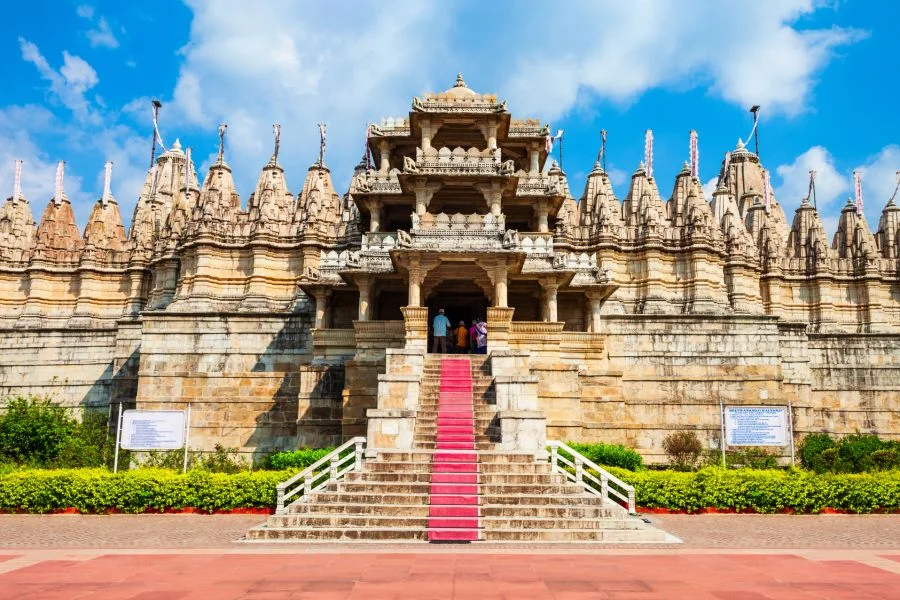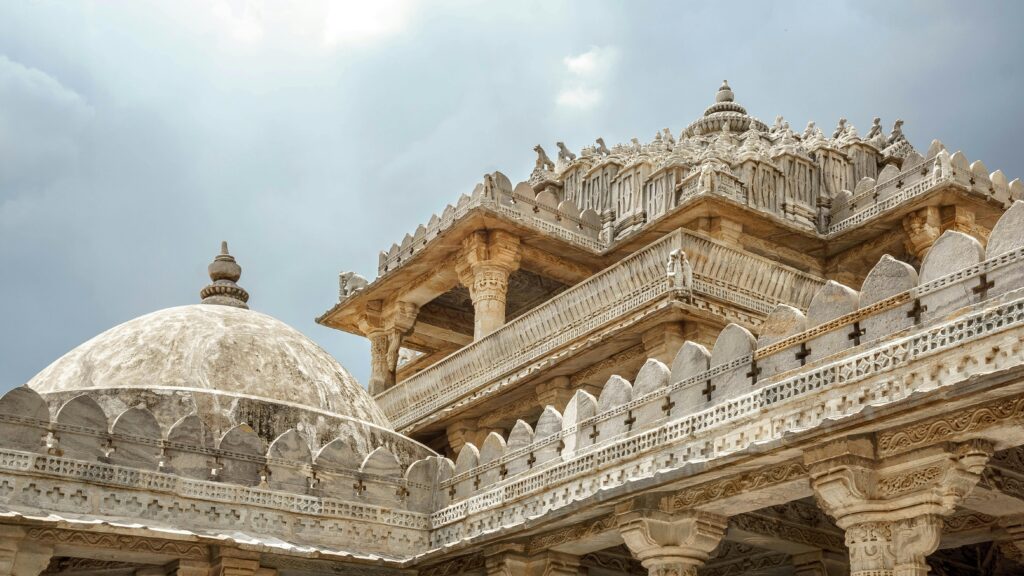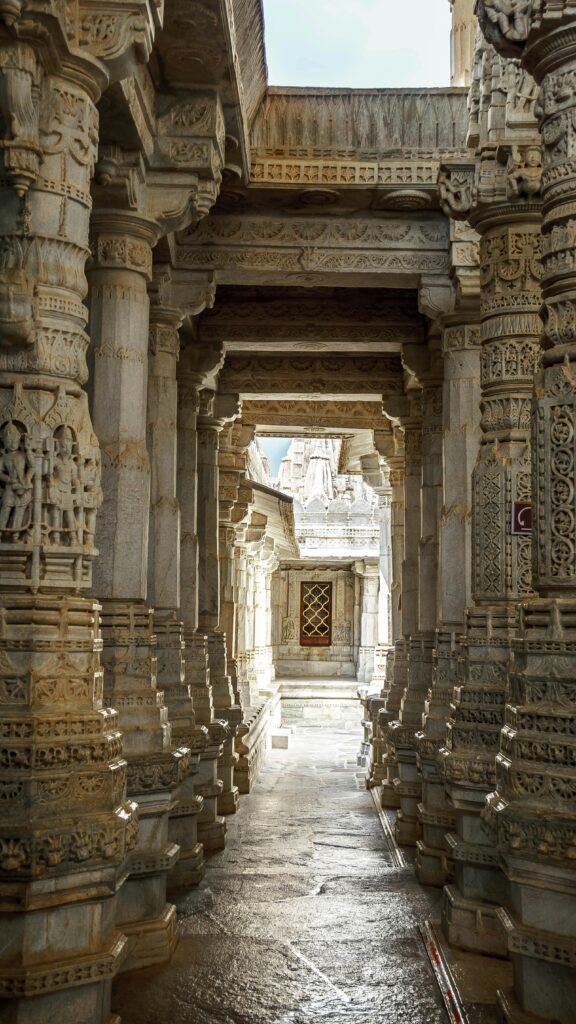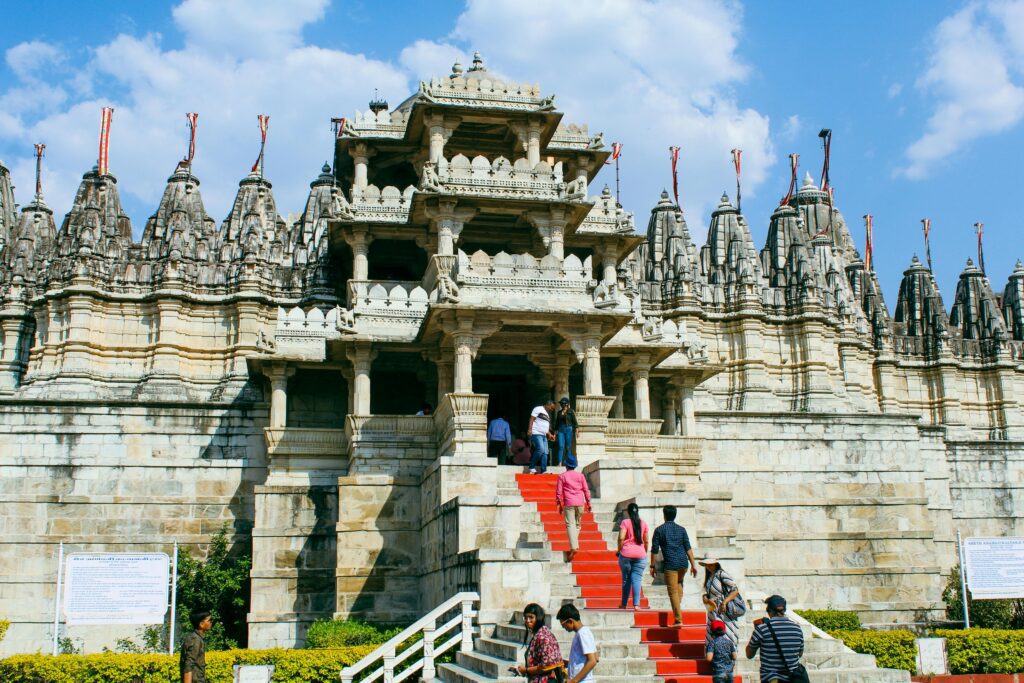
Table of Contents
Introduction
Located in the peaceful valleys of the Aravalli Range of the Pali district of Rajasthan, the Ranakpur Jain Temple is India’s most stunning expression of devotion carved out of marble.
Known for its precision skill, exquisite symmetry, and heavenly peace, the temple is a masterpiece of Jain architecture that never fails to fascinate historians, travelers, and architects across the world.
Dedicated to Lord Adinath (Rishabhanatha) — the original Jain Tirthankara — this temple is not merely a monument of worship but a living model of India’s artistic perfection and religious concord.
Every pillar, dome, and carving here is a testament to peace, precision, and spiritual perfection.
The Ranakpur Jain Temple occupies a special position in the cultural and architectural heritage of Rajasthan.
Situated among green hills and tranquil streams, the temple provides travelers with a cosmic experience — where art and religion are intertwined in harmony.
Its beauty lies not only in its marble complex but also in ageless passion that built it.
In this blog, we’ll explore the temple’s rich history, architectural wonders, and seven fascinating facts that make it one of the most remarkable creations in India’s religious architecture.
The Historical Background of Ranakpur Jain Temple
The origin of the Ranakpur Jain Temple dates back to the 15th century when Rana Kumbha, the powerful Rajput ruler of Mewar, was ruling supreme.
The temple is a culmination of the vision of a devout Jain merchant named Dharna Shah.
As per the myth, Dharna Shah received a divine vision in which Lord Adinath instructed him to build a temple in his honor symbolizing peace and wisdom.
Inspired by this divine task, he approached Rana Kumbha, king of Mewar, and requested land to construct the temple.
The king, impressed by his devotion, not just granted him land in the village of Ranakpur, but he also gave him full support to this religious quest.
The city was named after the king himself to recognize his contribution to one of India’s most imposing architectural marvels.
Work began in the mid-1400s and continued for nearly half a century. Dozens of artisans and sculptors from all corners of India were commissioned en masse to build what would become one of the largest Jain temples ever built.
The size of the temple spoke as much about Jain metaphysics as it did about medieval Rajasthan’s level of art sophistication.
In the past, the Ranakpur Jain Temple was a symbol of religious coexistence and cultural cooperation.
Although built by Jain patrons, it was patronized by Hindu kings — a reflection of the values of harmony that permeated medieval India.
Through the ages, historians, travelers, and architects have chronicled its beauty. Colonel James Tod, the Rajasthan historian of British India, described it as “a splendid example of ancient Indian architecture that defies time.”
Thus, the history of Ranakpur Jain Temple is not only about the temple’s construction but about spirituality, cooperation, and artistic skill that transcended kingdoms and faiths.
Architectural Brilliance: A Masterpiece of Marble
If there is one word that perfectly captures the essence of the Ranakpur Jain Temple, it is perfection.
The temple is a marvel of white marble architecture, best known for its exquisite craftsmanship, precise geometry, and breathtaking design.

Chaumukha Design
One of the most captivating and defining features of the Ranakpur Jain Temple is its Chaumukh design, which literally means “four-faced” or “four-directional.”
This unique architectural concept is not only a technical wonder but also a profound expression of Jain philosophy — representing the infinite reach of the Tirthankaras (spiritual teachers) in all directions, guiding humanity toward truth and enlightenment.
At the heart of the temple lies the main shrine dedicated to Lord Adinath (Rishabhanatha), the first Tirthankara of Jainism.
The sanctum, designed in the Chaumukh (four-faced) style, features four identical idols of Lord Adinath facing the four cardinal directions — North, South, East, and West.
This arrangement allows devotees to perform circumambulation (pradakshina) and offer prayers from any side, symbolizing that divine truth is accessible to all, regardless of direction or position.
From an architectural perspective, the Chaumukh design displays perfect symmetry and balance, a hallmark of ancient Indian craftsmanship.
The temple is planned as a vast geometric mandala, spreading outward from the central sanctum. Each corridor, pillar, and dome aligns harmoniously, creating a rhythm of space and light that seems almost musical.
The entire structure rests on a quadruple axis, dividing the temple into four equal parts, yet connecting them seamlessly through a maze of corridors and domed halls.
What truly sets this design apart is its ability to combine aesthetic beauty with spiritual symbolism.
The four faces of the deity signify the universal presence of truth, compassion, and enlightenment, while the open layout ensures a continuous flow of air and natural light, enhancing the temple’s serene atmosphere.
The 1,444 exquisitely carved marble pillars, each distinct in design, further amplify the perfection of the Chaumukh layout.
No two pillars are identical, yet together they maintain symmetry — a metaphor for unity in diversity within the Jain belief system.
In essence, the Chaumukh design of the Ranakpur Jain Temple is not just an architectural choice but a spiritual philosophy carved in stone.
It stands as a magnificent representation of balance, equality, and universal vision, embodying both the architectural excellence of the artisans and the spiritual depth of Jainism.
It’s this ingenious blend of form, faith, and function that makes the Ranakpur Jain Temple’s Chaumukh design a timeless marvel — one that continues to inspire architects, artists, and devotees across centuries.
Structure and Design
The temple complex is colossal — it covers 48,000 square feet in area. It contains:

29 halls
80 domes
426 columns
1,444 one-of-a-kind carved pillars
Every one of these pillars holds up the structure while contributing its own artistic character. Bafflingly, there are no two identical pillars; each pillar has unique carvings, designs, and angles.
The marble used for construction was locally sourced from the Aravalli mountains that were renowned for their milky-white hue and strength.
The change of light on these stones throughout the day changes the color of the temple — golden light in the morning and white in the evening.
Symbolic Design
The architecture is the Jain cosmological view of the universe — a central temple (garbhagriha) representing the purity of the soul in the center, and complex passages representing the path of life to enlightenment around it.
The domes are arranged in a gradual climb, therefore, representing spiritual ascension. The ceiling carvings in concentric circles represent cosmic harmony — the merging of geometry with philosophy.
In every imaginable way, the Ranakpur Jain Temple architecture is a fusion of science, spirituality, and art — an eternal encyclopedia of medieval engineering.
Delicate Carvings and Innovative Detailing
The most interesting aspect of the Ranakpur Jain Temple architecture is its carvings. Every surface — pillars, walls, domes, and ceilings — is inlaid with delicate sculptural work that is virtually impossible to copy with human hands.

The carvings depict a range of motifs:
Mythological figures from Jain cosmology.
Elephants, dancers, and celestial beings symbolizing grace and purity.
Floral and geometric designs symbolizing natural balance.
Scenes of meditation and spiritual enlightenment illustrating Jain doctrine.
The workmanship is incredible. On close inspection, you can see tiny leaves, flowers, and designs that seem to be alive on the marble.
Ceiling Artistry
The ceilings are probably the temple’s most artistic achievement. The central dome contains a fine carving of the celestial dancers encircling the lotus — representing divine wisdom. Each dome ceiling displays a specific motif, adding visual variety to the building.
Symbolism in Carvings
The carvings are not mere ornaments; they represent deep Jain symbolism.
Elephants represent strength and moral strength.
Lotuses represent purity of soul.
Geometric symmetry represents the Jain vision of balance and order.
The artistry of the Ranakpur Jain Temple is only matched by that of Mount Abu’s Dilwara Temples, but because of its sheer scale and variety, Ranakpur is unique.
It’s said that at night, when moonlight hits the marble, the carvings glow with divine energy — as if the temple breathes in unity with the universe.
The Main Deity and Spiritual Importance
At the heart of this architectural marvel lies its spiritual aspect — the sanctum of the original Tirthankara, Lord Adinath.
The main idol, made of white marble, lies majestically in the centre sanctum, facing all directions — symbolizing omniscience and universal compassion. The Chaumukha design facilitates worshippers from any direction approaching the Lord, symbolizing equality and universality of devotion.
Rituals and Worship
Daily prayers, recitation of Jain scriptures, and special rituals form the spiritual rhythm of the temple. The temple comes alive on Mahavir Jayanti and Paryushan Parva, when pilgrims from all over the world come to pray and meditate in silence.
Spiritual Design
The temple design is an expression of the path of the soul towards liberation.
The outer halls represent worldly life.
The innermost part represents spiritual realization.
The ascending domes represent the lifting of the soul towards enlightenment.
This blending of religious thought and architecture makes the Ranakpur Jain Temple greater than just a place of worship, it is a temple of knowledge and tranquility.
Seven Interesting Facts About Ranakpur Jain Temple
In addition to its towering architecture and religious enigma, the Ranakpur Jain Temple also has a few secrets tucked in its sleeves, which testify to just how advanced and innovative ancient Indian architecture was.
Each of these seven secrets adds another dimension of magic to its past and architectural brilliance.
It Took Over 50 Years to Complete
The construction of the Ranakpur Jain Temple began in around 1446 CE and continued for nearly half a century. The long duration wasn’t due to lag but dedication.
Every portion was manually chiseled out of pristine white marble mined from the Aravalli Hills.
Thousands of artisans worked under the supervision of master sculptor Depa, taking care that symmetry of the design was flawless.
Builders followed the Vastu-Shastra and Shilpa-Shastra principles, making each measurement correspond to divine geometry.
The long time span is not only a measure of complication but of the astounding dedication of a people who viewed the temple as an offering to God, and not as a building project.
No Two Pillars Are Identical
Perhaps the greatest mystery of the temple is that no two of its 1,444 pillars are the same.
Each pillar has distinctive floral, geometric, or figurative designs — some spiral, some straight, some angular.
The craftsmen avoided repetition intentionally to represent boundless creativity of the world.
More surprising, the pillars are aligned so neatly that each one doesn’t block the view of Lord Adinath’s idol from any point of the temple.
This reflects the architectural brilliance and space planning of craftsmen in 15th century well before the invention of any modern tools to aid design.
The Temple Changes Color with Sunlight
Ranakpur Jain Temple is famous for its living color — it seems to shift as the day progresses.
Morning sunlight lights up the marble with a golden hue, symbolizing spiritual insight.
At noon, the marble shines pure white, symbolizing peace and clarity.
At sunset, it glows bluish-silver in the fading light, mirroring meditation’s calmness.
This magical phenomenon occurs due to the high-grade crystalline marble that reflects and refracts sunlight differently at each hour.
It’s an architectural poetry that connects nature and spirituality — as if the temple breathes with the rhythm of time.
Ceiling Carvings Depict Celestial Scenes
Look upward inside the temple, and you’ll see marble transformed into heaven itself.
The ceilings have dainty concentric circles, flower patterns, and celestial dancers known as apsaras.
A gigantic lotus medallion at the center of the main dome symbolizes purity and liberation.
The other domes have the heavenly planes of Jain cosmology, showing how the souls journey toward enlightenment.
Every carving tells a symbolic story — of the universe, human values, and the cycle of birth.
These ceilings are not just architectural; they are pictorial scriptures carved on stone, conveying Jain philosophy in art.
Absolutely Symmetrical Alignment with Cosmic Directions
Temple’s Chaumukha (four-faced) plan is aligned exactly with the four cardinal directions — north, south, east, and west.
Such an arrangement offers light and air naturally at all times, keeping the temple illuminated without the support of artificial sources.
Alignment is as per Jain cosmographic belief, where the four directions symbolize universal truth, equality, and accessibility of enlightenment.
All the gateways lead to the center sanctum, showing that the path to the truth is accessible from every direction.
The precision of alignment indicates a high degree of knowledge of astronomy and geometry in the 15th century.
Built Completely Without Iron Reinforcement
Perhaps the most amazing aspect of the architecture of the Ranakpur Jain Temple is that it was built without iron or metal.
Marble domes and blocks of massive size are fastened together with interlocking joints and perfectly counterbalanced weighting, without steel or mortar.
The ancient technique gave the temple its flexibility and strength and allowed it to endure centuries of quakes and weathering.
Engineers are amazed at the way a building so massive — measuring nearly 50,000 sq. ft. — remains stable just by means of stone craftsmanship.
The absence of iron also conforms to Jain principles of purity, avoiding materials that can rust or become contaminated.
It’s a reflection of the way ancient Indian architects combined faith in religious conviction with scientific precision and constructed buildings that were meant to last an eternity.
One of the Largest Jain Temples in India
Stretching nearly 48,000 square feet with four satellite shrines, 29 halls, and 80 domes, the Ranakpur Jain Temple is considered to be one of the biggest and most significant Jain temples in the world.
It is one of the five prominent Jain pilgrimage sites along with Shravanabelagola, Palitana, Girnar, and Shikharji.
Its gigantic size allowed thousands of devotees to gather simultaneously for prayer and meditation.
Its ratio also symbolizes spiritual magnificence, reminding believers that God is infinite.
Ranakpur Jain Temple: A Traveler’s Guide
A pilgrimage for those who seek tranquility, beauty, and inspiration is an experience that no one can ever forget.
How to Reach
By Air: Nearest airport is Udaipur (91 km).
By Train: Nearest railway station is Falna (30 km).
By Road: Well connected from Udaipur, Mount Abu, and Jodhpur by road on picturesque routes.
Best Time to Visit
October to March is a good weather, the best time to go to the temple and its surroundings.
Temple Timings & Etiquette
From 6:30 AM to 5:00 PM.
Feet should be removed prior to entry.
Mild dressing is mandatory, and quiet within is appreciated.
Photography is allowed in some locations only.
Nearby Attractions
Kumbhalgarh Fort (a UNESCO World Heritage Centre).
Sadri town, renowned for other ancient Jain temples.
Mount Abu, another holy Jain pilgrimage destination.
A visit to Ranakpur Jain Temple is not just sightseeing but an excursion into the heart of India’s religious and architectural heritage.
Conclusion
Ranakpur Jain Temple is a beaming tribute to India’s ancient heritage’s spiritual devotion, architectural excellence, and artistry.
Located in the peaceful valley of the Aravalli hills, this resplendent temple pays homage to Jain philosophy as deeply as it does to human aspiration to become perfect through spirituality and art.
Each inch of the marble building — from its intricately carved pillars to its very ornate ceilings — bears testament to an eye beyond time.
The temple’s history tells of an era when art and religion were together with such harmony.
Built in the 15th century during the reign of Rana Kumbha, the temple is not just a religious building; it’s a reflection of India’s cultural heritage.
With its architecture characterized by cutting geometry, elaborate symmetry, and generous application of decorative carvings, it’s a work of perfection that no era of today can rival.
To the faithful, the Ranakpur Jain Temple is spiritual serenity — a place where the silence of stone speaks the voice of faith.
To historians and architects, it is an artwork that bears witness to the excellence of ancient Indian design and engineering brilliance.
And to the traveler, it is an inspirational odyssey, a place that draws together peace and beauty and history and the divine.
In every way, the Ranakpur Jain Temple is India incarnate — eternal, imaginative, and deeply spiritual.
Its history and building continue to inspire wonder and awe, reminding the world that greatness is not only built with stone but also love, determination, and vision.
Whether viewed from the perspective of religion or art, this temple is a timeless jewel of Rajasthan, which shines brightly in the pages of Indian heritage — a wonderful blend of religious serenity and architectural beauty which will continue to amaze for generations to come.
